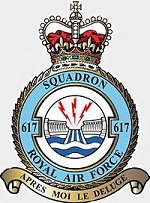Corgi AA32629 RAF Avro Lancaster B Mk. III Heavy Bomber - ED763 'KC-Z' "Honor", No.617 Squadron, 'Operation Catechism', Sinking the Tirpitz, November 12th, 1944 (1:72 Scale)
"Apres moi le deluge (French for 'After me, the flood')"
- Motto of No.617 Squadron
 Entering service at the beginning of 1942, the Lancaster's design grew out of a failed predecessor, the Avro Manchester. While its' airframe offered a stable platform for heavy bombing assignments, the Manchester's twin engine design was inadequate to the task. By upgrading to four Merlins, the resulting aircraft met the nation's needs and 7,366 Avro Lancasters were built during the war, the most of any British bomber. Armament included eight to ten Browning machine guns for fighter defense (depending on model variant) mounted in the nose, upper dorsal turret and the tail. Experience with a variety of bomb loads eventually led to adoption of the 'Grand Slam' 22,000-pound bomb, the largest carried by any aircraft in the war.
Entering service at the beginning of 1942, the Lancaster's design grew out of a failed predecessor, the Avro Manchester. While its' airframe offered a stable platform for heavy bombing assignments, the Manchester's twin engine design was inadequate to the task. By upgrading to four Merlins, the resulting aircraft met the nation's needs and 7,366 Avro Lancasters were built during the war, the most of any British bomber. Armament included eight to ten Browning machine guns for fighter defense (depending on model variant) mounted in the nose, upper dorsal turret and the tail. Experience with a variety of bomb loads eventually led to adoption of the 'Grand Slam' 22,000-pound bomb, the largest carried by any aircraft in the war.
The majority of Lancasters built during the war years were manufactured by Avro at their factory at Chadderton near Manchester and test flown from Woodford Aerodrome in Cheshire. Other Lancasters were built by Metropolitan-Vickers (1080, also tested at Woodford) and Armstrong Whitworth. The aircraft was also produced at the Austin Motor Company works in Longbridge, Birmingham later in the Second World War and postwar by Vickers-Armstrongs at Chester. Only 300 of the Lancaster B II fitted with Bristol Hercules engines were constructed; this was a stopgap modification caused by a shortage of Merlin engines as fighter production was of higher priority. Many BII's were lost after running out of fuel.
The Lancaster B III had Packard Merlin engines but was otherwise identical to contemporary B Is, with 3,030 B IIIs built, almost all at A.V. Roe's Newton Heath factory. The B I and B III were built concurrently, and minor modifications were made to both marks as new batches were ordered. Examples of these modifications were the relocation of the pitot head from the nose to the side of the cockpit, and the change from de Havilland "needle blade" propellers to Hamilton Standard or Nash Kelvinator made "paddle blade" propellers.
Of later variants, only the Canadian-built Lancaster B X, manufactured by Victory Aircraft in Malton, Ontario, was produced in significant numbers. A total of 430 of this type were built, earlier examples differing little from their British-built predecessors, except for using Packard-built Merlin engines and American-style instrumentation and electrics. Late-series models replaced the Frazer Nash mid-upper turret with a differently configured Martin turret, mounted slightly further forward for weight balance. A total of 7,377 Lancasters of all marks were built throughout the duration of the war, each at a 1943 cost of 45-50,000 (approximately equivalent to 1.3-1.5 million in 2005 currency).
For the dam-busting strike in May 1943, the Lancaster dropped British designer Barnes Wallis's 'bouncing bombs' which skipped on the surface before impact. Wartime Lancaster sorties totaled about 156,000 during which roughly 608,000 tons of ordnance were dropped on the enemy.
Pictured here is a 1:72 scale replica of a RAF Avro Lancaster B Mk. III heavy bomber that was nicknamed "Honor", and attached to No.617 Squadron, then involved in the attempted sinking of the German battleship Tirpitz on November 12th, 1944.
Now in stock!
Dimensions:
Wingspan: 17-inches
Length: 11-3/4-inches
Release Date: December 2024
 Historical Account: "Honor" - Operation Catechism on November 12th, 1944, would see another concerted effort by the Royal Air Force to destroy the mighty warship Tirpitz, with 18 Lancasters from No.617 Squadron and a further 13 from No.IX Squadron taking off from their temporary bases at Lossiemouth and Milltown in northern Scotland heading for Tromso Fjord.
Historical Account: "Honor" - Operation Catechism on November 12th, 1944, would see another concerted effort by the Royal Air Force to destroy the mighty warship Tirpitz, with 18 Lancasters from No.617 Squadron and a further 13 from No.IX Squadron taking off from their temporary bases at Lossiemouth and Milltown in northern Scotland heading for Tromso Fjord.
All the aircraft carried more than a maximum fuel load for a Lancaster and were again loaded with Tallboy bombs, but this time, their flight path would skirt Swedish airspace, attacking Tirpitz from the opposite direction, hoping to catch the German defenders by surprise. As the Lancasters began their attack run, they could clearly see Tirpitz from as far as 20 miles away and significantly, could see no Luftwaffe fighters. Despite attracting the attentions of heavy defensive fire, the bombers pressed home their attack, with the first Tallboy being released at approximately 08.40.
Over the course of the next few minutes, Tirpitz was subjected to an almost constant stream of these devastating bombs, with at least two scoring direct hits, and others detonating close enough to the ship to cause further damage. Just minutes after the first bomb had been released, Tirpitz was seen to start listing to port, initially appearing to settle at an angle of around 35 degrees as water flooded in, but following a massive explosion ten minutes later, continued her death roll.
Her fate was sealed -- Tirpitz immediately capsized and the Lancasters turned for home.


